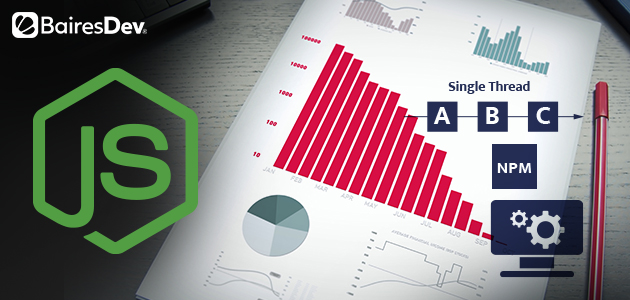Whether you're developing a real-time application, an IoT device, or a high-traffic website, Node.js can deliver speed, efficiency, and lower development costs.

When developing an application or software, choosing a backend technology is a crucial task. If you're a fan of the popular JavaScript programming language, you used to have to find another option for server-side development. With Node.js, full-stack JavaScript development is now possible.
What is Node.js?
Node.js is an open-source server environment that runs cross-platform using JavaScript. It is not a framework, but an execution environment that allows you to execute JavaScript code on the server side. It's popularity has increased dramatically since it was released in 2009, along with a growing demand for Node JS development and support services.
Node.js has several core elements, including:
Motor
Node.js development is based on the Google Chrome V8 JavaScript engine, which makes it very fast and lightweight for code execution.
Event-driven architecture
Node.js does not create multiple threads for each request or wait for one request to finish before starting another. It runs in a single thread and initiates multiple simultaneous requests. If no data is returned when the server calls the Application Programming Interface (API), it moves on to the next API. The events module helps the server to get a response from the previous API.
Node Packet Monitor
Node.js development is supported by a document-based database model rather than SQL. Node Package Monitor (NPM) has the world's largest open source library registry from which you can easily import any functionality you need for your application. With access to NPM, you can reuse code to build applications faster.
Advantages of Node.js development

Node.js development is designed to easily create fast, scalable web applications and develop solutions for high-traffic needs. Offers a wide range of advantages:
- Easy to learn : Since most developers already know JavaScript, it's easy to get started with Node.js without much of a learning curve. If you understand JavaScript, you will know how to write Node.js applications.
- Scalable and Efficient : The microservices feature of Node.js divides different aspects of the application into separate services, each of which handles different tasks. This process makes it easier to scale applications and implement additional functions as needed. With full stack JavaScript app development, you can code with a common programming language for front-end and back-end. This convenience makes it easy to send data between server and client and facilitates instant data synchronization.
- Supports data streaming: Node.js development reduces processing time while uploading audio and video files. Instead of buffering data, it generates it in chunks, sending one chunk at a time to the end user. These Node.js “streams” increase memory usage only by the size of the chunk and not the entire file, supporting real-time video or audio encoding.
- Reduces development costs : Serverless capability allows applications to automatically scale in response to traffic spikes. As a result, you only pay for services when the functions are used, not all the time, resulting in lower costs than with standard server architecture.
Additionally, with Node.js development, you can merge the front-end and back-end teams into a smaller team of developers to work on the entire application.
Plus, because Node.js is open source, you avoid licensing fees. Its extensive community gives you access to advice and tips from expert developers, including best practices for Node JS security, and offers a wide range of free customization features.
The following video describes some of these advantages:
Disadvantages of Node.js

There are some drawbacks to Node.js development, mainly regarding the single-threaded feature and the wide options in NPM.
Operating with a single main thread is not suitable for heavy calculations as its efficiency decreases as CPU load increases. Once a resource-demanding request enters the event loop, it prevents other incoming requests from being responded to until it completes, reducing response speed. If you are working with large amounts of data on the server side, you may need different technology.
Relying on third-party modules in NPM comes with some disadvantages. While a large number of options can be an advantage, it can also be difficult to find and choose the right modules. Because anyone can upload free libraries and resources, quality and reliability vary widely. Therefore, you should choose only verified sources.
Best Industries and Businesses for Node.js Development

Node.js development is flexible enough to work in large companies with large-scale projects, given its microservices capabilities. It can also serve smaller startups well, given its scalability and lower development costs. A wide range of industries use Node.js successfully, including online entertainment, e-commerce, real estate, payment services, and online publishing.
Some of the most well-known companies have used Node.js, based on the specific benefits it provides for their development projects:
Netflix
- Scalability
- Handling data-intensive applications
Walmart mobile app
- Advanced features offered on the client side
- Efficient handling of concurrent requests
Uber
- Facilitation of a complex matching system
- Active open source community
PayPal
- Fast construction times
- Processing large amounts of data
Best projects for Node.js development
While it works well for a wide variety of projects, Node.js development is particularly effective for data-intensive real-time, Internet of Things (IoT), and high-traffic applications.
Node.js is lightweight and efficient for applications that require a continuous connection from the browser to the server, which allows it to be updated immediately with new posts or user actions.
Additionally, Node.js can implement microservices for tracking and other features of the geographically distributed systems that make up the IoT. Real-time capabilities and a data-centric approach make it popular for IoT applications and devices.
Node.js also works well for applications that expect a large traffic load that processes a large number of requests on the client side. It can simultaneously handle multiple requests and provide immediate responses.
When NOT to use Node.js
There are some situations where you can't or shouldn't use Node.js. You cannot use it in the browser because it is a JavaScript runtime, which already exists in the browser. You should not use it for image and graphics processing or video and audio editing.
Node.js is not the best choice for Artificial Intelligence (AI) and machine learning, although it has libraries and tools to incorporate AI-based elements into applications if necessary. Node.js also overcomplicates the development of simple applications that transfer data directly from the server.
Node.js Enables Full Stack JavaScript Development
JavaScript fans can pursue full-stack development with the help of Node.js. Whether you're developing a real-time application, an IoT device, or a high-traffic website, Node.js can deliver speed, efficiency, and lower development costs.
If you liked this article, check out our other guides below;
- Change Node Version: A Step-by-Step Guide
- Node JS Cache: Increasing Performance and Efficiency
- Unlock the power of Node.JS microservices
- Unlocking the Power of Websocket Nodejs
- Best Text Editors and Node JS IDE for App Development




















































